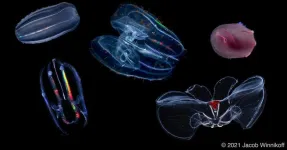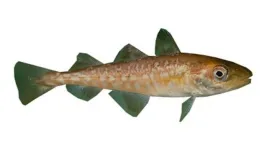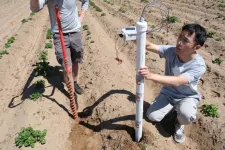(Press-News.org) Plants are powerhouses of molecular manufacturing. Over the eons, they have evolved to produce a plethora of small molecules — some are beneficial and valuable to humans, others can be deadly. For years, a good way for scientists looking for new medicines to distinguish beneficial plant-derived molecules from harmful ones has been through a scientific sniff test — dab a bit of the molecule at one end of a petri dish and drop tiny nematode worms (C. elegans) at the other, then wait to see if the chemically sensitive worms move toward or away from the compound in question, a process known as chemotaxis.
This “artisanal” method is achingly slow. It can take two hours to assay a single new molecule. But now a team at the Wu Tsai Neurosciences Institute at Stanford University, led by Miriam Goodman, a professor of molecular and cell biology, has developed hardware and software that turns an off-the-shelf flatbed scanner into a lab platform that can evaluate dozens of chemotaxis samples in minutes. The platform can prep 20 plates at a time and fit four plates on a scanner to perform 80 chemical assays in about an hour.
“In the artisanal days, if someone were really skilled and had done all the prep work and had all the materials, it might take two weeks to do that many assays,” Goodman said. The team describes the components of their DIY platform and offers the open-source code in a new paper in the journal PLOS Biology.
The big idea
It sounds simple, but developing the platform has been anything but for the team, which included co-investigators Seung “Sue” Y. Rhee, Director of the Plant Resilience Institute at Michigan State University (formerly of the Carnegie Institution for Science at Stanford), and Thomas R. Clandinin, professor of neurobiology at Stanford. It took the trio and their labs more than five years to design, create, test, and evaluate their approach from inception to publication.
The project, dubbed the ‘Neuro-Plant Initiative” was seeded by the “Big Ideas in Neurosciences” grant program at Wu Tsai Neuro. These flagship research projects included five-year grants and were charged specifically with bringing together diverse teams of researchers to gain deeper understanding of the brain and behavior in health and disease.
The initiative required experts in neurosciences, animal and plant biology, laboratory sciences, mechanical engineering, and computer science. The team now hope the platform becomes ubiquitous and leads to rapid discovery of promising new molecules for use in medical, biology, agricultural, and neurosciences labs currently mired in artisanal methods.
“In the nematode research community, there are roughly 1200 labs across the world,” Goodman noted. The platform could prove useful for discovering other kinds of chemicals or identifying which species of bacteria attract or repel nematodes that eat bacteria, she explained.
Myriad possibilities
Co-author Sue Rhee, who is MSU Foundation Professor in the Departments of Biochemistry & Molecular Biology, Plant Biology, and Plant, Soil & Microbiology studies how plants make a myriad of compounds and use them to communicate with their environments. Of the hundreds of thousands of compounds that plants produce, Rhee says we know very little about how they are made or used in nature.
“A long-standing dogma is that they are used to defend against pests or to attract pollinators, but only a tiny number of these compounds have known roles,” Rhee said. “Through this ingenious high-throughput chemotaxis assay, I hope that we can start to unravel these chemical mysteries at scale.”
Co-author Thomas Clandinin is a neurobiologist who studies how animals use specific sensory inputs to select appropriate behavioral actions. His lab contributed to the development of a way to stabilize worms when suspended in liquid, facilitating automated methods for dispensing worms at the scale needed to move away from the artisanal method.
“Developing this automated method to examine chemotaxis behavior at scale will open a host of new possibilities for exploring the rich connections between odors and their receptors,” Clandinin said.
Next steps
Next up, Goodman hopes to put their invention to work in her own neurosciences lab to understand the neural and chemical basis of the nematodes’ ability to distinguish good molecules from bad. She is pursuing a collaboration with researchers at Harvard University to use calcium imaging to record the activity of all the worm’s olfactory — or smell-sensitive — neurons as it is moving toward or away from a molecule. In that work, Goodman plans on making use of her assay platform to do behavioral research at greater scale, manipulating individual neurons in the worms’ nervous system and eventually matching compounds to receptors.
The nematodes’ sniff test is a skill shared by many animals, including humans, Goodman points out. She hopes to apply these learnings in neuroscience to that intriguing subject, work she is certain will be accelerated by this new platform. Whether in worms or humans, she says, the chemical receptors in the olfactory system binding to these molecules are holding on to the exact same chemical.
“The shape of those binding pockets ought to be similar in both beings. Even if they are dissimilar, it will be helpful to know that,” Goodman said. “That is research I'm really excited about.”
END
The worm has turned: DIY lab platform evaluates new molecules in minutes
2024-06-27
ELSE PRESS RELEASES FROM THIS DATE:
Under pressure: How comb jellies have adapted to life at the bottom of the ocean
2024-06-27
The bottom of the ocean is not hospitable: there is no light; the temperature is freezing cold; and the pressure of all the water above will literally crush you. The animals that live at this depth have developed biophysical adaptations that allow them to survive in these harsh conditions. What are these adaptations and how did they develop?
University of California San Diego Assistant Professor of Chemistry and Biochemistry Itay Budin teamed up with researchers from around the country to study the cell membranes of ctenophores (“comb jellies”) and found they had unique lipid structures that allow them to live under intense pressure. Their work appears in Science.
Adapting ...
A CHARMed collaboration created a potent therapy candidate for fatal prion diseases
2024-06-27
EMBARGOED UNTIL 27-Jun-2024 14:00 ET
Drug development is typically slow: the pipeline from basic research discoveries that provide the basis for a new drug to clinical trials to production of a widely available medicine can take decades. But decades can feel impossibly far off to someone who currently has a fatal disease. Broad Institute Senior Group Leader Sonia Vallabh is acutely aware of that race against time, because the topic of her research is a neurodegenerative and ultimately fatal disease–fatal familial insomnia, a type of prion disease–that she will almost certainly develop as she ages. Vallabh and her husband, Eric Minikel, switched careers ...
Researchers find flexible solution for separating gases
2024-06-27
For a broad range of industries, separating gases is an important part of both process and product—from separating nitrogen and oxygen from air for medical purposes to separating carbon dioxide from other gases in the process of carbon capture or removing impurities from natural gas.
Separating gases, however, can be both energy-intensive and expensive. “For example, when separating oxygen and nitrogen, you need to cool the air to very low temperatures until they liquefy. Then, by slowly increasing the temperature, the gases will evaporate at different points, allowing one to become a gas again and separate out,” explains Wei Zhang, a University of Colorado Boulder professor ...
Pacific cod can’t rely on coastal safe havens for protection during marine heat waves, OSU study finds
2024-06-27
During recent periods of unusually warm water in the Gulf of Alaska, young Pacific cod in near shore safe havens where they typically spend their adolescence did not experience the protective effects those areas typically provide, a new Oregon State University study found.
Instead, during marine heat waves in 2014-16 and 2019, young cod in these near shore “nurseries” around Kodiak Island in Alaska experienced significant changes in their abundance, growth rates and diet, with researchers estimating that only the largest 15-25% of the island’s cod population survived the summer. Even after the high temperatures subsided, the ...
Bird flu stays stable on milking equipment for at least one hour
2024-06-27
Bird flu, or H5N1 virus, in unpasteurized milk is stable on metal and rubber components of commercial milking equipment for at least one hour, increasing its potential to infect people and other animals, report researchers from the University of Pittsburgh School of Medicine and Emory University in Emerging Infectious Diseases.
The study underscores the heightened risk of bird flu exposure for dairy farm workers and signals the need for wider adoption of personal protective equipment, including face shields, masks and eye protection.
“Dairy cows have to be milked even if they are sick, and it has not been clear for how long the virus contained in residual milk from the ...
Printed sensors in soil could help farmers improve crop yields and save money
2024-06-27
MADISON — University of Wisconsin–Madison engineers have developed low-cost sensors that allow for real-time, continuous monitoring of nitrate in soil types that are common in Wisconsin. These printed electrochemical sensors could enable farmers to make better informed nutrient management decisions and reap economic benefits.
“Our sensors could give farmers a greater understanding of the nutrient profile of their soil and how much nitrate is available for the plants, helping them to make more precise decisions on how much fertilizer they really need,” says Joseph Andrews, an assistant professor of mechanical ...
Neighborhood opportunities influence infant development and cognition
2024-06-27
Growing up in neighborhoods with more educational and socioeconomic opportunities has a positive impact on infants’ brain activity, according to new research from Boston Medical Center (BMC). The study, published in The Journal of Developmental & Behavioral Pediatrics, suggests that enhancing neighborhood opportunities, particularly in education, can be a promising approach to promoting early childhood development.
A team of early childhood researchers examined how neighborhood opportunity – the socioeconomic, educational, health, and ...
New twists on tornadoes: Earth scientist studies why U.S. has so many tornadoes
2024-06-27
WEST LAFAYETTE, Ind. — Across the Midwest during the warmer months, studying the sky for signs of storms and tornadoes becomes one of the most popular pastimes.
Dan Chavas, an associate professor in the Department of Earth, Atmospheric, and Planetary Sciences at Purdue University’s College of Science, takes it further: All day every day, he studies what makes tornadoes tick. Working at the intersection of climate science and meteorology, he looks at the big picture of what causes severe storms and tornadoes — and what dictates where ...
Children’s Hospital of Philadelphia researchers find elementary age children experience more concussions during activities unrelated to sports
2024-06-27
Philadelphia, June 27, 2024 – Researchers from Children’s Hospital of Philadelphia (CHOP) found that young children between the ages of 5 and 12 were more likely to experience a concussion from recreation and other non-sport activities, yet those injuries were not seen by specialists until days later compared with sports-related concussions in the same age group.
This study suggests concussion research is needed for children outside of sports and that providing more resources and education ...
Ultrasounds may not find this cancer in Black women
2024-06-27
A common algorithm to check for endometrial cancer is not reliable for Black women, according to a new study published today in JAMA Oncology.
In Black patients with concerning symptoms, a tissue biopsy is strongly recommended to rule out endometrial cancer instead of using transvaginal ultrasound, the report concluded.
Endometrial cancer is the most common type of gynecological cancer in the United States. It is one of the few types of cancer now on the rise, especially among Black women, who are more likely to be diagnosed at later stages of the disease. This cancer can cause symptoms such as abnormal vaginal ...



